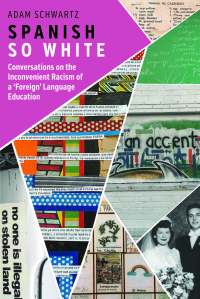We recently welcomed Lily, a sixth-form student, to the office for some work experience with us. While she was here, she did a project for us about how she and her peer group consume books and explored the use of different formats through one of our titles, Spanish So White, which is available in hard copy, ebook and audiobook. In this post, she talks about the ways in which A-Level students consume and utilise reading material, particularly nonfiction.
A-Level students’ use of nonfiction
 The majority of the consumption of nonfiction writing by sixth-form students is, undoubtedly, for studying rather than for entertainment. Most students seek out very little study-related reading material of their own volition, and there is limited access to academic material in the school.
The majority of the consumption of nonfiction writing by sixth-form students is, undoubtedly, for studying rather than for entertainment. Most students seek out very little study-related reading material of their own volition, and there is limited access to academic material in the school.
Sixth-formers generally constrain themselves to the textbooks they are allotted by the school. Personally, I am in the minority in that I have received journals/magazines/academic writing in addition to my textbook for my Economics A-Level studies. I am also currently reading The Immortal Life of Henrietta Lacks by Rebecca Skloot – a nonfiction novel in paperback – to contextualise and better understand content in the A-Level biology curriculum.
Most of the required academic or nonfiction material is paperback textbooks, occasionally provided additionally as an ebook by a teacher. Typically, paperback textbooks are lighter and more accessible (such as in a classroom) than a hardback, as well as more memorable than an ebook.
Fiction for study purposes
Sixth-formers’ consumption of fiction for studying is still limited. In general, the majority of this reading is for arts or humanities such as history and English literature. For example, to further engage with required English literature A-Level texts, I have read a selection of poetry, 19th century European novels, and 20th century American literature. All of these I have read in paperback.
Personally, I am more inclined to purchase an ebook to read for entertainment (although my contemporaries tend to read borrowed paperbacks). This is because digital formats are more accessible and faster to read; I own almost double the number of ebooks than hardbacks or paperbacks, yet the majority of my nonfiction is in paperback.
Spanish So White
 Within my sixth-form community, there is little exploration of life outside of individuals’ personal bubbles. This is partially due to a lack of motivation or inspiration, but also due to limited accessible academic writing about the wider world.
Within my sixth-form community, there is little exploration of life outside of individuals’ personal bubbles. This is partially due to a lack of motivation or inspiration, but also due to limited accessible academic writing about the wider world.
The book Spanish So White by Adam Schwartz has expanded my contextual and historical understanding of learning or speaking Spanish. As an aspiring Spanish learner, it has changed my perspective on how I have accessed or been taught the language.
While my preference for a paperback edition of a book still stands (especially for nonfiction, as it is more comprehensible to follow the intended layout and structure), the audiobook encouraged a more measured pace. Hearing the spoken Spanish which Schwartz had written about was a useful way to connect with the book.
The ebook of Spanish So White was still a useful resource, but it was more challenging to pace the reading and fully appreciate the ‘pause points’. To me, the physical book is more memorable, as I can associate photos with subheadings. The book has, thus, left a more lasting impression on me than it perhaps might have if I’d only accessed a digital format.
Lily McKay